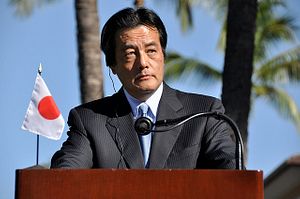If the purpose of Japanese Prime Minister Shinzo Abe’s December 14 snap election was to claim a mandate for Abenomics and his decision to delay the consumption tax hike scheduled for this October, the supermajority his Liberal Democratic Party (LDP)-Komeito coalition won may have been a hollow victory negated by the dismal turnout – a postwar low of 52.7 percent of eligible voters. However, if the purpose was to take advantage of the opposition’s disarray, then Abe’s strategy has worked brilliantly. The Democratic Party of Japan (DPJ) — Japan’s largest opposition party, which upended LDP dominance to claim power from 2009 to 2012 — only managed to increase its number of seats from 62 to 73. That’s far short of the 100 needed to make the DPJ a serious contender for a majority in 2018. Even more significantly, Banri Kaieda, the DPJ president, lost his seat. It is the first time in Japan that the leader of the main opposition party has been unseated since 1949.
Now the DPJ faces an intraparty election on January 18, with a focus on how to revitalize the party as a serious contender against the LDP. Three members have announced their candidacy: former Health Minister Akira Nagatsuma (54), acting president of the DPJ Katsuya Okada (61), and former DPJ Secretary-General Goshi Hosono (43). Nagatsuma is famous for having helped expose a scandal over the mishandling of data concerning the national pension system. Okada will try to turn his seniority into a positive affirmation of his rich experiences as a politician. Over on the other end of the age spectrum, Hosono will use his youth to his advantage, arguing that “we must part with the past. I want to show the public that the DPJ has changed.”
Nagatsuma is the most liberal of the candidates. Notably, he is opposed to allowing Japan to use force to defend allies under attack, as he believes it will be too difficult to limit the scope of such a legal expansion of military activities. Nagatsuma is supported by many DPJ members who were former members of the Japan Socialist Party, as well as by members who were elected from public sector labor unions, such as the leftist Japan Teachers’ Union. Nagatsuma has been the most confrontational towards the LDP, remarking at a recent press conference, “The Cabinet of Prime Minister Shinzo Abe does not seem to be reflecting on the war 70 years ago and acting accordingly. Extremely dangerous moves are gathering pace.” This might make Nagatsuma the candidate most appealing to South Korea and China, as both those countries have made similar criticisms of Abe’s administration.
Okada, representing the mainstream of the DPJ, was ambiguous on the question of Japan’s right to collective self-defense. When asked about the topic, he answered that “we will be playing into the hands of the ruling megacoalition if all we do is oppose government policies.” Previously, Okada served as foreign minister and deputy prime minister. When Yukio Hatoyama resigned in 2010 there was speculation that Okada might run for the DPJ presidency, but as NPR reported at the time, “his involvement in discussions over the Futenma base issue might be viewed as a negative by the voters.” The Futenma base issue was a particular thorn in the U.S.-Japan relationship under Hatoyama’s leadership, a broken campaign promise that led to his resignation.
Hosono, who very consciously places himself in the “third generation” of DPJ leadership, is trying to frame the election as an opportunity for a generational shift. He is the most supportive of collective self-defense, and wants to set up a legal framework that will allow for a smoother Japanese response to crises on the Korean peninsula. Hosono is seen as the most conservative of the three, and in the past has expressed a willingness to merge with the right-wing Japan Innovation Party, though he has changed his opinion on that – stating that such a merger would be unrealistic since announcing his bid.
A Yomiuri Shimbun survey conducted a week before the election sees Okada and Hosono leading among DPJ Diet members, with about 40 supporters each, while 30 lawmakers support Nagatsuma and 20 are still undecided. However, the outcome is far from clear as local assembly members and rank-and-file party members get to vote in the party’s presidential election as well. If no contender wins a majority of the votes on Sunday, it will proceed to a runoff between the top two candidates. In a runoff, local assembly members and rank-and-file party members will not be eligible to vote – the DPJ presidency could come down to whether Okada or Hosono can woo more of Nagatsuma’s backers to their side.
Whoever wins the DPJ presidency will face the uphill challenge of regaining credibility in the eyes of Japanese voters, after being tainted by the image of incompetence during their first tenure as the ruling party.

































